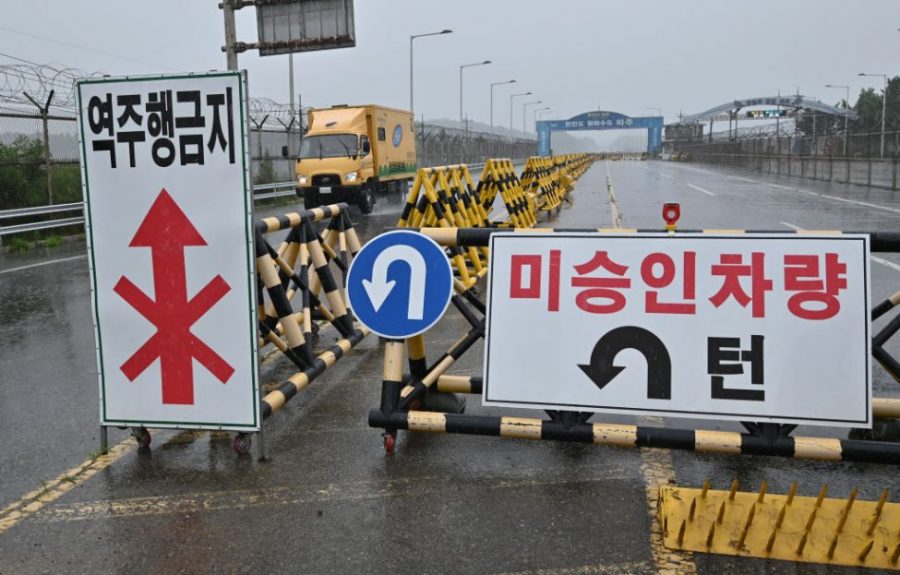
Like the leading character in a long-running television series, North Korean leader Kim Jong-un kicked off the latest crisis on the Korean peninsula with familiar theatrics. After cutting off all communications with South Korea earlier this month, the Kim regime blew up the building in which it had previously hosted South Korean diplomats. It redeployed troops into demilitarised border areas and issued renewed threats of violence against the South. Those displays of bombast followed Kim’s scene-stealing performance in May, when he announced that North Korea would boost its investment in ‘nuclear war deterrence’.
Yesterday, however, North Korean state media reported that the country’s Central Military Commission has decided to suspend ‘military action plans’ against South Korea. How long this interlude will last is anyone’s guess. The meeting, chaired by Kim, also reportedly considered documents outlining measures for ‘further bolstering the war deterrent of the country’.
Washington has so far ignored the latest episode, and for good reason. After two years of playing along with President Donald Trump’s made-for-TV summitry, Kim is convinced that the ‘bromance’ storyline has run its course, and that an older narrative will keep his ratings up.
Having banked his political gains from Trump’s fecklessness, Kim is now unambiguously asserting North Korea’s status as a nuclear power. To drive that point home, he promoted the general in charge of the nuclear program to serve as vice-chair of the Central Military Commission, while also rewarding 69 other generals who have contributed to the country’s strategic success in recent years.
Since the failed nuclear summit in Hanoi in February 2019, Kim has been consistent in both word and deed. Last April, he warned that Trump had until the end of last year to lift US sanctions on North Korea. Since then, the North has continued its short-range missile testing (chalking up noteworthy successes), expanded a missile production plant and built new support facilities for its missile program.
Clearly, Trump’s ‘maximum pressure’ campaign to choke off North Korea’s clandestine sources of income and trade has utterly failed to alter the course of the regime’s nuclear and missile programs. American officials acknowledged as much last month when the US Department of Justice indicted 28 North Korean and five Chinese officials and bankers for (successfully) circumventing the sanctions regime. Since 2014, the indictment alleges, the North’s global network of front companies has—with China’s help—funnelled US$2.5 billion into Kim’s nuclear weapon, missile and high-tech programs.
Kim has been no less consistent in expanding North Korea’s massive conventional military capacity. While its military hardware remains far inferior to the US-furnished armour and aircraft across the border, the North has nonetheless managed to upgrade both the accuracy and reach of its weapons. It has also placed 70% of its 1.1 million-strong army within 100 kilometres of the demilitarised zone, putting South Korea’s capital well within its sights. By one estimate, the North could rain down 25,000 artillery rounds on the Seoul metropolitan area—including a major US military compound—in the space of just 10 minutes.
To be sure, US and South Korean forces would have a major technological edge in an all-out war on the peninsula. But even a short-lived conflict would be devastating to Seoul, which is home to some 25 million people and accounts for half of South Korea’s population and 70% of its GDP.
Against this background, Trump’s effort to extort South Korea to quadruple its financial support for US forces stationed there is astonishingly irresponsible. Although negotiations to renew the expired US–South Korean cost-sharing pact remain at an impasse, a new stopgap deal at least ends the furlough of 4,000 South Koreans who work at US facilities. But with Seoul temporarily assuming the cost of these salaries, the deal will hardly improve Trump’s standing in the eyes of South Koreans.
Kim can take further comfort from the fact that Trump has also been browbeating Japan, demanding that it, too, boost its financial support for US forces within its borders. Though Japan is crucial to South Korea’s defence, the two countries have a rocky relationship. Last year, South Korea threatened to pull out of a bilateral intelligence-sharing arrangement before reversing course under US pressure. As in South Korea, most Japanese have no confidence in Trump’s handling of international affairs. Such factors inevitably will contribute to diplomatic disarray between the US, South Korea and Japan, all of which will benefit Kim.
In addition to undermining US alliances in the region, Trump is also doing Kim a favour by escalating tensions with China, which now will be less inclined to rein in its client state. With China accounting for over 90% of North Korea’s trade, Kim has been cultivating a closer relationship with Chinese President Xi Jinping, who visited Pyongyang last June. That meeting and others suggest that China has been neither surprised nor particularly concerned about Kim’s behaviour.
This is not to suggest that Kim has clear sailing ahead. Owing to US sanctions, limited food production and various reform failures, North Korea faces formidable challenges at home. Following a speech at the Workers’ Party of Korea’s annual plenum in December, public remarks issued by Kim in February and April suggest that he may have spent the first half of this year focusing on domestic priorities. By forcing the closure of the Chinese border, the Covid-19 pandemic has undoubtedly hurt the North’s faltering economy. And the fact that Kim has imposed tougher oversight on implementation of his previous economic reforms suggests that more domestic trouble may be on the horizon.
With or without economic problems, Kim is unlikely to deviate from his family’s well-rehearsed oeuvre. Like past performances by his late father and grandfather, his repertoire will continue to feature threats of violence, sensational provocations and potentially even military incidents like the shelling of South Korean islands a decade ago. All signs indicate more brinkmanship on the part of the North. The leading character in the Korean peninsula’s long-running psychodrama may still be new, but the play remains the same.

